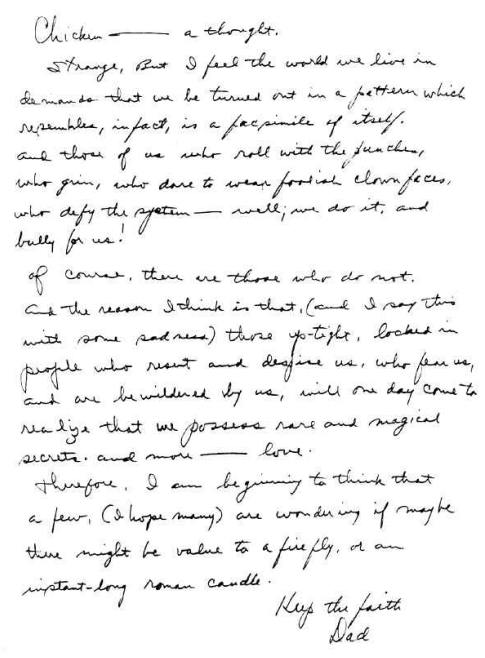|
The most striking quality in Frank Sinatra’s handwriting is the deep
emotional content and intensity of feeling that permeates every letter
and indeed the whole page of his writing.
Not only did his emotions play an important role in his life; they
were a force that drove him. Nevertheless, despite the intensity of
his emotions he appears to have been strangely unable to give complete
expression to his feelings within his relationships.
Numerous signs of repression throughout the writing show how he tried
to suppress some of his feelings. (There are restrictions, left-tending
strokes, redrawn strokes and many angles).
Somehow, perversely, he
only managed to show the opposite of what he intended. Indeed, in
all its volatility, it is a somewhat tortured writing that attests
to the constant battle raging within him.
Fortunately for the world, however, he was able to give expression
to the depth of his feelings through his singing and it was this genuine
display of emotionality combined with his superb musicality that was
the wellspring of his genius.
It was this magical combination that
found an echo in the dreams of people all over the world.
Here is a sample of his handwriting:
 Strong pressure, some well-developed lower extensions especially
in the p’s, a certain pastosity and some notable forward drive all
point towards strong physicality – and indeed, he was a man of action.
But there is also a strong restless quality in the handwriting and
he was constantly forced to contend with the conflict within his personality.
Conflict did not only surface within his relationships but it was
actually built into his very fibre so that it was his constant, often
unwelcome companion.
He was often drawn to people but at the same time he resented them
and tried to build a defensive wall against them.
He seethed with
numerous strong resentments that were so well–entrenched in his personality
that they seemed to bubble up from deep within his psyche and probably
had their first origins way back in his childhood.
He was suspicious of people’s
intentions and hated to be imposed upon. He appears to have been on
constant guard against people who might try to take advantage of him.
He was tough and critical of others as well as of himself but he
hated to be criticized by anyone and he probably lashed out defensively
at those who attempted to foist their unwanted and usually unsolicited
opinions on him.
There is a rubbery resilience to his writing that speaks of a strong
ability to bounce back. There is also evidence of a very strong personal
drive that was rooted in his powerful will to achieve.
This was reinforced by his unrelenting determination to get his own
way. In fact, he was capable of bulldozing over anyone who stood in
his way. (Note the long and powerful down strokes counter-balanced
by relentlessly tough and down–slanting t-bars.)
And of course he continued to do things his own way throughout his
life – a fact that is graphologically substantiated by the strong
individualism so clearly apparent in his handwriting.
His independence and ability to stand alone are evident in the completely
unpretentious quality of the writing, the clear spacing between the
lines, repeated upright letters and some shortened d-strokes.
He badly wanted to be loved (although he allowed few people to get
close to him) and there is much evidence of love and warmth in his
writing. Note the right slant, the full warm strokes, and the almost
soft, rounded shapes in the very word, "love" towards the
end of his letter.
Nevertheless, he apparently went to great lengths to conceal this
softer option of his personality not allowing it to be seen except
through the context of his singing.
In fact his lyrical and poetic
side that was such an important part of his make-up was only accessible
to the world through his singing. His songs were his lifeline to the
world.
There is a great deal that you can learn about yourself too, from
your own handwriting.
If you would like to find out how to do this
go to
The Hidden Meaning of
Handwriting
|